Located in My Loc commune, southern Long An province, the 200 year-old Ton Thanh Pagoda is specially bonded to Nguyen Dinh Chieu, a great poet and patriotic scholar as he lived and created the most celebrated works in Vietnamese literature there.
According to history books, Ton Thanh Pagoda with its initial name of Lan Nha was built by Buddhist monk Vien Ngo in the year of the 7th Gia Long (1808).
In the year of the 5th Thieu Tri, Buddhist monk Vien Ngo, who followed the Buddhist religion for 40 years but did not reach the peak of the way in his religion, decided to sit in meditation without drinking water for 49 days and then passed away.
To commemorate the monk who devoted his whole life to the Buddhist religion, the locals call the pagoda Tang Ngo or Ong Ngo and Lao Ngo.
Sixteen years latter, Ton Thanh Pagoda became famous for being the place where poet Nguyen Dinh Chieu wrote “Van Te nghia si Can Giuoc” (Funeral Oration for the Partisans of Can Giuoc).
During three years living in the pagoda, from 1859 to 1861, the blind poet wrote many literary works and made up medicine to treat the locals.
In a surprise attack on Tay Duong Military Post in Truong Binh Market on the night of the 15th day of lunar calendar in the Year of Cock (1861), one of the three wings of Can Giuoc Insurgent Army started from Tan Thanh Pagoda.
The insurgent army killed a mandarin of the French, called Hai Phu Lang Sa by the locals. Being moved and fired up by the courageous sacrifices of Can Giuoc soldiers, poet Nguyen Dinh Chieu created “Van te nghia si Can Giuoc” at Ton Thanh Pagoda.
At present, the relics of poet Nguyen Dinh Chieu and the “Van te nghia si Can Giuoc” are still preserved at the precinct of the pagoda. They are two steles, one about poet Nguyen Dinh Chieu built in 1973 and the second excerpting “Van te nghia si Can Gioc” built in 1998.
In the garden of the pagoda, there are a three-story tower in the shape of hexagon, 4.5m high, of monk Vien Ngo with the highest storey inscribed with scripts “Glory to Buddha Amitabha” and a square three-storey Tower, 3m in height of Buddhist Monk Tac Thanh.
After being restored several times, the pagoda has experienced a lot of changes. It now consists of a complex of a worshiping hall, a sanctum, a preaching house and corridors in the west and the east.
In particular, the pagoda only preserves the old architectural style with a system of four pillars in the main sanctum, several Buddhist statues from the early 19th century, parallels and the most valuable statue of Ksitigarbha Bodhisattva made from bronze.-VNA



















